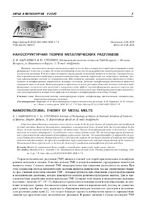Наноструктурная теория металлических расплавов
Another Title
Nanostructural theory of metal melts
Bibliographic entry
Марукович, Е. И. Наноструктурная теория металлических расплавов = Nanostructural theory of metal melts / Е. И. Марукович, В. Ю. Стеценко // Литье и металлургия. – 2020. – № 3. – С. 7-9.
Abstract
Показано, что атомная и атомно-кластерная теории не могут быть основой для теорий кристаллизации и модифицирования металлов и сплавов. На основе термодинамических расчетов разработана наноструктурная теория металлических расплавов. В этой теории основными структурными элементами являются не атомы, а нанокристаллы. Они термодинамически стабильны в металлическом расплаве, поэтому определяют его структуру и свойства. Центры кристаллизации состоят из нанокристаллов. Интенсивность агрегации нанокристаллов определяется концентрацией демодифицирующих поверхностно-активных элементов. Действие модификаторов объясняется процессом связывания этих элементов. Наноструктурная теория металлических расплавов объясняет механизм действия модифицирующих неметаллических включений и интерметаллидов, эффект перемодифицирования, высокую скорость кристаллизации при большой интенсивности охлаждения металлического расплава. Наноструктурная теория металлических расплавов является основой для теорий кристаллизации и модифицирования металлов и сплавов.
Abstract in another language
It has been shown that atomic and atomic cluster theories cannot be the basis for theories of crystallization and modification of metals and alloys. Based on thermodynamic calculations, a nanostructural theory of metal melts has been developed. In this theory, the main structural elements are not atoms, but nanocrystals. They are thermodynamically stable in the metal melt, so they determine its structure and properties. Crystallization centers consist of nanocrystals. The intensity of aggregation of nanocrystals is determined by the concentration of demodifying surface-active elements. The action of modifiers is explained by the process of linking these elements. Nanostructural theory of metal melts explains the mechanism of action of modifying non-metallic inclusions and intermetallics, the effect of re-modification, high crystallization rate with high cooling intensity of the metal melt. Nanostructural theory of metal melts is the basis for theories of crystallization and modification of metals and alloys.
View/
Collections
- № 3[21]

